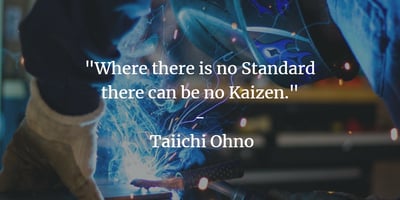 We spend a lot of time in this blog focused on the “what” and “why” of Lean and continuous improvement. Today, we thought it would be interesting to take a look at some of the “who" (and we don't mean the classic band).
We spend a lot of time in this blog focused on the “what” and “why” of Lean and continuous improvement. Today, we thought it would be interesting to take a look at some of the “who" (and we don't mean the classic band).
The term Lean was first coined by John Krafcik in his 1988 Sloan Management Review article “Triumph of the Lean Production System.” The approach gained traction after the publication of The Machine That Changed the World, by James Womack, Daniel Jones, and Daniel Roos in 1990.
The term Lean manufacturing may be less than 30 years old, but the thinking that inspired it has been around since the pre-industrial age. The leaders who developed this approach understood the need for continuous improvement and empowered employees. They learned from each other, eventually building our modern approach to business process improvement and management. Here’s some background on a few of the most important contributors to Lean leadership.
Frederick Winslow Taylor (1856-1915)
Frederick Winslow Taylor was an American mechanical engineer who is thought to have been one of the first management consultants. In a way, his work was a precursor to modern Lean. He was devoted to the study and improvement of industrial efficiency. His 1911 book The Principles of Scientific Management was voted the most influential management book of the twentieth century by the Academy of Management in 2001. Taylor understood that the ability to efficiently develop people was as important to business success as efficient product production. He said,
“In the past the man has been first; in the future the system must be first. This in no sense, however, implies that great men are not needed. On the contrary, the first object of any good system must be that of developing first-class men; and under systematic management the best man rises to the top more certainly and more rapidly than ever before.”
Henry Ford (1863 – 1947)
Much of the talk about Lean and other business improvement systems focuses on the Japanese auto industry, but much of the foundation for that work started with Henry Ford. Ford Motor Company was founded in 1903 with the introduction of the Model A. The Model T was released in 1908 after more than 20 design changes. Ford built his cars to be both easy to use and easy to build with simple, interchangeable parts. Ford may not have used the term “value stream,” but he certainly understood it. After World War II, Toyota learned from the books and work of Henry Ford that had been published decades earlier, but then built upon his work (and combined with other influences including W. Edwards Deming).
“There is one rule for the industrialist and that is: make the best quality goods possible at the lowest cost possible, paying the highest wages possible.”
Sakichi Toyoda (1867–1930)
Sakichi Toyoda has been called the “King of Inventors.” Of course, we associate the Toyoda family with cars, but Sakichi Toyoda’s original claim to fame is the invention of the Japanese power loom. He developed the loom as a way to reduce the amount of manual labor and effort needed for weaving, an industry that employed many members of his family. Sakichi Toyoda’s Type-G loom didn’t just stop when the yarn broke, it also had automatic shuttle change, which reduced the need for human intervention in its normal operations, and was a breakthrough that had eluded everybody else. In fact, the sale of the patent rights for the loom to an English company in 1929 provided the capital necessary for entry into the automotive industry.
W. Edwards Deming (1900–1993)
W. Edwards Deming was an American statistician and professor who became known as a quality and management guru, first through his work with Japanese industry after World War II. A few decades later, he finally received recognition and attention from American companies, including Ford Motor Company, and was featured in an NBC documentary titled, "If Japan Can, Why Can't We?" Deming's books, including Out of the Crisis and The New Economics document and expand upon what he taught Toyota and other companies and management and improving quality.
Deming said:
“American management is quick to assign blame to an individual when the problem, is in fact, a fault in the system."
In recent years, Shoichiro Toyoda, the Honorary Chairman and Director of Toyota, said:
“There is not a day I don’t think about what Dr. Deming meant to us. Deming is the core of our management.”
Kiichiro Toyoda (1895–1952)
Kiichiro Toyoda was the son of Sakichi Toyoda and second President of Toyota Motor Company. It was his decision to move from producing weaving looms into the automobile business. Mr. K. Toyoda was very much influenced by his trips to Ford plants. Like Mr. Ford, he believed in "Just In Time" production and the “pull” of inventory through the production system. Even while still in the loom business, Kiichiro Toyoda understood that continuous improvement was the key to staying competitive.
“The thieves may be able to follow the design plans and produce a loom. But we are modifying and improving our looms every day. They do not have the expertise gained from the failures it took to produce the original. We need not be concerned. We need only continue as always, making our improvements.”
Eiji Toyoda (1913 – 1999)
Eiji Toyoda was a younger cousin of Kiichiro Toyoda. E. Toyoda was President of Toyota Motor Company from 1967-1982. Toyoda visited one of the Ford plants in Michigan during the early 1950s. He was impressed by the scale of the facility but recognized significant inefficiencies. To date, Toyota Motor had been manufacturing cars for 13 years and had produced just over 2,500 automobiles. The Ford plant, on the other hand, was making 8,000 vehicles a day. Toyoda decided to adopt American automobile mass production methods but with a focus on quality. Toyoda, along with Taiichi Ohno developed the initial concepts that became known as the “Toyota Way,” including Kanban, Kaizen, and "respect for people."
Taiichi Ohno (1912-1990)
Taiichi Ohno was a Japanese industrial engineer and businessman. He is considered to be the father of the Toyota Production System, which became known widely as "Lean Manufacturing" in the U.S. He formulated the seven wastes as part of this system. He wrote several important books about the approach, including Toyota Production System: Beyond Large-Scale Production.
“If you are going to do Kaizen continuously, you’ve got to assume that things are a mess. Too many people just assume that things are all right the way they are. Aren’t you guys convinced that the way you are doing things is the right way? That’s no way to get anything done. Kaizen is about changing the way things are. If you assume that things are all right the way they are, you can’t do Kaizen.”
Shigeo Shingo (1909-1990)
Shingo was one of Japan’s foremost consultants on manufacturing operations improvement and worked with Toyota to develop their TPS methods. He wrote many books on improvement including: Revolution in Manufacturing: The SMED System and Zero Quality Control: Source Inspection and the Poka-Yoke System. In 1988, the Jon M. Huntsman School of Business at Utah State University recognized Dr. Shingō for his lifetime accomplishments and created the Shingo Prize for Operational Excellence that recognizes world-class, Lean organizations and operational excellence. He offered one of our favorite quotes on Lean leadership:
“Even the greatest idea can become meaningless in the rush to judgment. To gauge an idea as feasible we must cut our ties to the status quo and find the balance between constructive criticism and judgment. Within that balance we will uncover critical input for making our ideas a reality.”
James Womack and Daniel Jones
For our final entry, we list James Womack and Daniel Jones together because they have worked together researching the automotive industry since 1979. Their research with MIT professor Daniel Roos on the automotive industry found a three-to-one productivity difference between Japanese and American factories. Their work led to the book we mentioned at the beginning of this post, The Machine that Changed the World. This book is widely credited with bringing the principles of Lean to boardrooms and factory floors across the United States.
“We labeled this new way Lean production because it does more and more with less and less.”
Of course, there are many others who contributed to today’s interpretation of Lean Leadership. But if you want to learn more about the evolution and execution of Kaizen in the workplace, reading the work of any of these pioneers is a great place to start.



Add a Comment